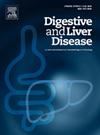Clinical characteristics and risk factors of hepatocellular carcinoma development in Budd-Chiari syndrome patients after endovascular treatment
IF 3.8
3区 医学
Q1 GASTROENTEROLOGY & HEPATOLOGY
引用次数: 0
Abstract
Background and Aims
Endovascular treatment has improved Budd-Chiari syndrome (BCS) patient outcomes, but patients remain at risk for developing hepatocellular carcinoma (HCC). We aimed to analyse the characteristics and risk factors for HCC development in BCS patients after endovascular treatment.
Methods
Clinical data of BCS patients who had received endovascular treatment were retrospectively reviewed. Characteristics of BCS patients who developed HCC post-treatment were compared with those without HCC development. Univariable and multivariable Cox regression analyses were used to determine the risk factors.
Results
We enrolled 302 BCS patients. HCC was confirmed in 31 patients after treatment. Early-stage tumours were the most common (11/31, 35.5 %) according to the Barcelona Clinic Liver Cancer staging system. A serum alpha fetoprotein (AFP) cut-off level of > 15.7 ng/mL showed a sensitivity of 69.3 % and specificity of 97.4 % for detecting HCC in these patients. The presence of preoperative liver cirrhosis (hazard ratio (HR)=4.677; P = 0.043) and postoperative restenosis (HR=6.867; P < 0.001) were independent risk factors associated with HCC development in BCS patients after endovascular treatment.
Conclusion
HCCs that develop after endovascular treatment in BCS patients are often detected at an early stage. Preoperative liver cirrhosis and postoperative restenosis were independent risk factors for HCC development in these individuals.
布-恰利综合征血管内治疗后肝癌发生的临床特点及危险因素分析。
背景和目的:血管内治疗改善了Budd-Chiari综合征(BCS)患者的预后,但患者仍有发展为肝细胞癌(HCC)的风险。我们的目的是分析血管内治疗后BCS患者HCC发展的特点和危险因素。方法:回顾性分析经血管内治疗的BCS患者的临床资料。将治疗后发生HCC的BCS患者的特征与未发生HCC的患者进行比较。采用单变量和多变量Cox回归分析确定危险因素。结果:我们入组了302例BCS患者。31例患者经治疗后确诊HCC。根据巴塞罗那诊所肝癌分期系统,早期肿瘤最常见(11/31,35.5%)。血清甲胎蛋白(AFP)截止水平为> 15.7 ng/mL,检测HCC的敏感性为69.3%,特异性为97.4%。术前存在肝硬化(危险比(HR)=4.677;P = 0.043)和术后再狭窄(HR=6.867;P < 0.001)是血管内治疗后BCS患者发生HCC相关的独立危险因素。结论:BCS患者在血管内治疗后发生的hcc通常在早期被发现。术前肝硬化和术后再狭窄是这些个体发生HCC的独立危险因素。
本文章由计算机程序翻译,如有差异,请以英文原文为准。
求助全文
约1分钟内获得全文
求助全文
来源期刊

Digestive and Liver Disease
医学-胃肠肝病学
CiteScore
6.10
自引率
2.20%
发文量
632
审稿时长
19 days
期刊介绍:
Digestive and Liver Disease is an international journal of Gastroenterology and Hepatology. It is the official journal of Italian Association for the Study of the Liver (AISF); Italian Association for the Study of the Pancreas (AISP); Italian Association for Digestive Endoscopy (SIED); Italian Association for Hospital Gastroenterologists and Digestive Endoscopists (AIGO); Italian Society of Gastroenterology (SIGE); Italian Society of Pediatric Gastroenterology and Hepatology (SIGENP) and Italian Group for the Study of Inflammatory Bowel Disease (IG-IBD).
Digestive and Liver Disease publishes papers on basic and clinical research in the field of gastroenterology and hepatology.
Contributions consist of:
Original Papers
Correspondence to the Editor
Editorials, Reviews and Special Articles
Progress Reports
Image of the Month
Congress Proceedings
Symposia and Mini-symposia.
 求助内容:
求助内容: 应助结果提醒方式:
应助结果提醒方式:


